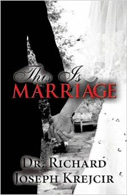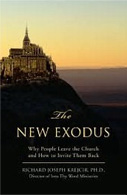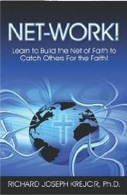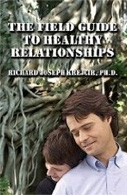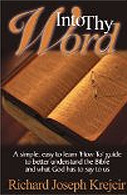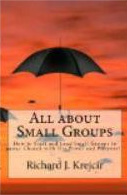General idea: The first covenant that God gave the Jews was His witness to humanity; these were specific precepts on how to come before Him. First was the sacred tent of the tabernacle that had separate compartments with symbols of His Holiness and how He had revealed Himself to them. Every furnishing had a meaning and an impact that showed God and pointed us to Christ who fulfilled it all. First, there was an entranceway, then the first room, containing a lampstand, an altar, and a curtain, behind which was the most holy place where the Ark of the Covenant and Aaron's staff were kept. The priests went before God and offered sacrifices in the first room, but the second room was only approached once a year after the high priest purified himself of his sins, so he could present an offering for the sins of the people. This was a shadow of the Person and Word that Christ would do and now has done. All of this ritual was to be done continually, the offering of sacrifices to God as well as the giving of atonement from God, but they were limited in that they had to be persistently repeated. The Great News of the Gospel is it is finished; we have the once and for all sacrifice of Christ. This old system was a ceremony of cleansing pointing to the One who would truly cleanse. It was limited, but Christ is not; He is everlasting power.
Contexts and Background:
This passage makes the writer's main point, that returning to the old way was useless; the new Way is right. This is a summation of the Old Testament sacrificial system and the role of the Tabernacle and the Temple. The purpose of any ancient temple was the message of a god(s) to its people, the regulations, and the role of its representatives, the priests. But the One True God made it plain that knowing Him and His customs, and that He is Holy are necessary to make atonement for one's sins. These regulations had to be performed for a Holy God in order to receive forgiveness and to point to the sufficient work and power of Christ to fulfill them all once and for all. Christ did not have to keep going to the altar to die; He is sufficient.
Commentary - Word and Phrase Meanings:
· First covenant. Meaning an agreement (contracts) between two parties-God and His people. This is the system with which God deals with humanity. The two main covenants are the first one, between God and Adam (the start of the Law, fully realized under Moses), and the "Covenant of Grace" between the Father and the Son (Heb. 13:20), where the Father gives the elect to the Son, and the Son must redeem them (us.)Both of these covenants were made before the world and humanity began. The Law God gave Moses included 619 various regulations for how man is to come before God and what He requires-and that is blood!
· Worship. Meaning giving honor to God. A comparison between what God expects in the Old Testament, and how we were not able to meet His standards, but Christ does so in our place (Psalm 100).
· Earthly sanctuary/holiness. The tent and then the Temple, the building of men to copy the sanctuary of God. This also refers to the holiness of God and our duty and call to worship Him and Him only. Today, Christians gather, as a congregation, to collectively praise and honor Christ and offer themselves to Him in sacrifice. Life and Church are about how our Lord and Savior, Jesus Christ, is worthy. All of the furnishings, separately indicated in this passage, show how close God is, but He can't be reached because of sin. A sacrifice was needed; blood was required to purify and for our forgiveness (Ex. 3:14-15; Lev. 17:11; Isa. 41:4; Rev. 1:4).
· Tabernacle. Meaning God's heavenly dwelling on earth built under Moses, this, this refers to the tent made by Moses and Aaron and the inner sanctum of God's most holy of holies that contained the Ark with the two tablets of the Testimony Moses brought from Mount Sinai. This represented God's home on earth as a "copy" of God's Throne Room, made for His presence in the inner chamber of Jewish Temples and the Tabernacle that was a tent, used before Solomon built the Temple. Now, Jesus is the real heavenly version (Ex. 24:9-11; 25; 25:40; 32:15; 38:21; Deut 10:5; 1 Kings 5-7; 22:19; 2 Chron. 2-4; Is. 6; Ezek. 1; 10:1; Dan. 7:9-10; Matt. 5:15; 13:38; John 8:42-45; Heb. 8:1-6; 9:1-14; Rev. 3:12; 4:1; 7:15; 11:19; 14:15-17; 15:5-16:1, 16:17; 21:22).
· Lampstand/candlestick. This refers to one of the main furnishings in the tent/ Temple, similar to the menorah in Jewish tradition today and made by hammered, pure gold. Along with this were seven oil lamps that were kept burning every night. It was placed at the south side of the inner sanctum, the Holy Place. This also refers to the O.T. account of how God's Glory descended into the Tabernacle. Now, our purpose is to point to His glory, that Christ is the light of the world now and as His Church we are to reflect Him to others. Here, the Old transitions to the New; the Son, Jesus Christ, is the True Temple, the Church is the true place of reverence to God, and Christianity is the true practice of Judaism under this New Covenant. The image that God is Light now refers to the Church as the body of believers whose duty it is to be a light as a witness for Christ. His character is the Light we follow and proclaim. Christ is the Priest, Head, Lord, and Prime Shepherd of the Church. He is the Object and Reason why we meet and function. Then, they referred to God's Light; now in the New Covenant, the Church is the light to the world for God's Glory. Christ is the destiny and pattern we follow and emulate (Gen. 1:3; Ex. 25:31-40; 40:24; 1 Kings 7:49; Zech. 4:2; Matt. 5:14-16; 18:20; 28:20; John 1:4-5; 8:12; 14:18; Acts 26:13; Eph. 1:10; 5:8-13; Phil. 2:15; 1 John 1:4-5; Rev. 2:9; 3:9).
· Tent. The first temple was a tent because the Jews, as their other name indicates, were nomadic for forty years. The tent had to be able to be picked up, packed, moved, and set up again without disrespecting God's Holy of Holies or His dignity. This system was kept up until David made provision for a permanent Temple that his son Solomon would build.
· Table. The table was made of acacia wood and then overlaid with gold and it was set at the north side of the Holy Place. This was where the offerings were made-the grain, wine, and oil as well as the sacrifices of animals (Ex 40:22).
· Consecrated bread/showbread. This is the bread, twelve loaves, set in two rows of six that were offered before God for His honor, common in all ancient places of worship, both pagan and traditional. Many liturgical churches, such as Catholic, still do this today as an offering and in remembrance of Christ. This means we place before God the best of ourselves and our things (Lev. 24:5-6; Matt. 12:4; Mark 2:26; Luke 6:4)
· Holy Place. The inner sanctuary where the Ark of the Covenant was kept. In context, this seems to indicate how the priest (only once a year and only one person of Israel) had a close relationship to God on the Day of Atonement. This is when the high priest took the incense from the altar/table, along with the blood of the sin offering, into the Most Holy Place (Ex. 40:5; Lev 16:12-14; 1 Kings 6:22).
· Curtain/veil. The hanging, thick tapestry separating the main room from the inner sanctum represented God's untouchable holiness. This is where God revealed His presence once a year to the high priest and pointed to a day when He would be revealed to all. To those in Christ, the veil is torn because of His blood, so Christ is now revealed to all who accept Him as Lord and Savior (Matt. 27:5; Heb. 10:20).
· Most Holy Place. This perhaps refers to the altar inside the inner chamber where the incense was burned.
· Incense was to appease God and cover the stench of the slaughter of the animals. In the most holy place, this burning of incense also clouded the vision of the priest so he could not gaze on the ark and shield his sin from God's powerful and overcoming holiness and purity (Ex. 40:26; Lev. 16:12-13).
· Gold-covered. Gold refers to the costliness of God's bending to seek humanity and communicating the wonders and preciousness of His holiness. It was made of acacia wood, which was the only wood available in the Sinai Desert; the Temple was made of cedar from Lebanon (Ex. 30:6; 1 Kings 6:22).
· Ark of the Covenant. An ark is basically a chest similar to the ones the Egyptians used for their holy doings. This one was made of acacia wood and overlaid with gold; the tablets of the Ten Commandments and a jar of manna were kept in it (Ex. 16:33-34; 25:10-16; Num. 17:8-10). See Hebrews 6:13-20 study for more insights and details on this passage.
· Aaron's staff. This is the staff that Aaron used in the Exodus to walk and to lead. God used it to show His power and affirm Aaron's priestly privilege when he was challenged. The point here is that true, priestly leadership only comes from God's choosing and anointing (Num. 17:10).
· Cherubim/cherubs. These are the two gold sculptures of winged figures made of one piece of hammered gold on top of the "mercy seat." It is also called the atonement cover of the ark, which was a slab made of pure gold on which the blood of the sin offering was sprinkled by the high priest once a year on the Day of Atonement. This represents God's heavenly couriers facing each other and pointing to God's holiness (Ex. 25:17-22; Lev. 16:1-15; Num. 7:89).
· Cannot discuss …in detail. Possibly meaning the writer did not want to go on with the details of Jewish worship, which they already knew, but focus on what they needed to know. Greek philosophers at this time, like the Jewish Philo, loved to go on and on about symbolism. The writer did not want to fall in that line and allow his audience to miss the point that Jesus supersedes the old covenant, as He becomes the New Covenant.
· Entered the inner room…once a year. Priests went into the second room daily for prayers, lighting the candles, and replacing the offertory bread just as Catholic priests do today.
· On the Day of Atonement. This is what is now celebrated as "Yom Kippur," celebrated the tenth day of the seventh month of the Jewish calendar (Ex. 25:30; 27:20-21; 30:7-9; Lev. 16:29-34; 24:5-9; Luke 1:8-10; Rev. 8:3). See 8:11 study for more info.
· Never without blood. Meaning the personal atonement, the cleansing ritual and purification that the priests had to go through; now Christ is our Purification.
· As long as the first tabernacle was still standing. As long as the Temple remains and is used, the Mosaic system will remain in effect. Two years after this letter, in 70 AD, it was destroyed and so was the system (Heb. 8:7-13).
· Illustration/figure. This is the Greek word for "parable," a method of articulating a saying that has an impacting meaning. This reminds the recipients of this letter that returning to the old way was useless and the new Way is right (Luke 4:23; Heb. 5:1; 11:19).
· Present time. The Temple and all of its rituals were going strong at this time, but soon it would come to a complete close and the Gospel would come about and supersede it-as it has done.
· External regulations. The Mosaic system only dealt with the external; Christ deals with the internal and eternal-the matters of the heart!
· New order/reformation. Referring to the New Covenant, as Christ is the new sanctuary and new sacrifice. The meaning is to be set on the right path or right order, or getting ourselves lined up as a plumb line to God's Way and precepts. The order of the Mosaic customs had profound meaning that had to be done by God's prescribed plan. Christ fulfils this; the question this passage begs is this: are we properly lined up to Christ?
Devotional Thoughts and Applications:
The Old Covenant was ritual and compulsion; its regulations were meant to point to God's holiness. However, it had one major fallacy: it did not call to the heart of humanity. Hearts could not be changed; there was no gratitude, only obligation and duty. The priests and system only dealt with the external-the surface that constantly needed purification, coming from unwilling people bringing their unwilling animals. Jesus, the willing sacrifice, became our redemption. He laid His own life down on our behalf. The Great Purifier dealt with our inward consciences, minds, and hearts. Christ compels us to be grateful and wondrous to His Person and work, so we will have love and a genuine response of the heart that builds. We are drawn in-our heart to His-because He is the Better Sacrifice! Trust Him! Allow Jesus to draw you deeper into His recesses of Fruit and Love so it flows in you and also flows from you (John 10:14-18; Gal. 5).
The Essential Inductive Questions (for more Inductive questions see Inductive Bible Study):
1. What does this passage say?
2. What does this passage mean?
3. What is God telling me?
4. How am I encouraged and strengthened?
5. Is there sin in my life for which confession and repentance is needed?
6. How can I be changed, so I can learn and grow?
7. What is in the way of these precepts affecting me? What is in the way of my listening to God?
8. How does this apply to me? What will I do about it?
9. What can I model and teach?
10. What does God want me to share with someone?
Additional Questions:
- How do you feel when you go to a great museum and there are those "off limits" or "do not enter signs?" How would you feel if Jesus was "off limits" and you could not commune with Him unless you made elaborate preparations and for only once a year?
- What does it mean to you to eagerly wait in Christ? How is Christ sufficient for you? How can He be more so?
- How does this summation of the Old Testament sacrificial system give you a better picture of who Christ is and what He did for you?
- What does it mean to you that you personally have a Living God who cares deeply for you and does not want you to wander off His path?
- What does God's everlasting power mean to you? How does it affect your daily life? How can it do so more?
- How would you describe the old system? How would you feel today if your church ceremony was limited and temporary in its cleansing power? How do you feel that Christ truly cleanses? How so?
- Why do you think God made it plain for all to know He is Holy and His customs are necessary for us to know Him and that He makes atonement for our sins?
- How did the writers' main point-that returning to the old way was useless and the new Way is right-come across to you? Would you have been convinced?
- Does this passage show you that God has always had a unified redemptive plan and purpose in place? How does this make you feel?
- How does it make you feel that Jesus cares and deals with our internal selves, in matters of the heart? Why is this more important than just dealing with the external? If we had our internal life on the right path, how would our external be?
- How are you an evidence of His work? How do your devotion and obedience please Christ? How do they not? How can they do so more? What are you going to do about it?
- What do you need to do to make sure your heart is lined up to His?
© 2008 R. J. Krejcir Ph.D. Into Thy Word Ministries www.intothyword.org.





